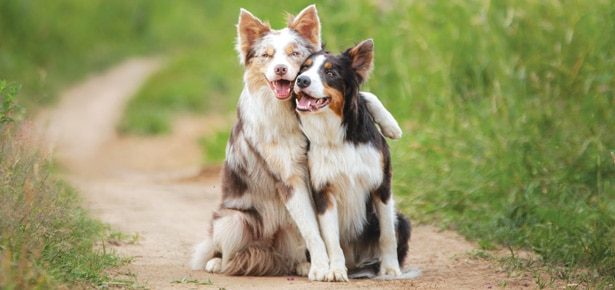

The Basenji
Out of Africa, into your heart
A few years ago, I was chatting with a Dog Show Judge who asked me what kind of dogs I had. “I have two Basenjis,” I happily replied. Her smile turned to a frown and her next words were, “Oh, what horrible little bush dogs.”
I took no offence. Long ago, I learned that the Basenji is a polarizing breed, one you’ll either love with a passion or want absolutely nothing to do with.
The Basenji Club of America (BCOA) notes that cave paintings in Libya dating back to 6000 BC feature pariah dogs that bear strong resemblance to the Basenji. In recent years, DNA testing has identified the Basenji as an early example of canine development.
This ancient breed is native to Central Africa, where Basenjis were—and still are—used to assist hunters by driving game such as antelope into nets. These dogs hunt by sight and scent, and their prowess is matched by a fearless and determined nature. No doubt, a large part of the breed’s survival over the centuries stems from the value it has consistently brought to a tribe’s table.
Efforts to bring the breed from the Congo to Europe and beyond began in the 1880s, but weren’t successful until the mid-1930s. A standard was developed and today the American Kennel Club (AKC) allows for a height range from 16 inches to 17 inches at the withers and a weight of 22 to 24 pounds. Accepted colour varieties include red, black, tricolour, and brindle.
The exotic look of the Basenji sets it apart from the crowd, and the same can be said about its unique temperament. Is this breed half-cat? Well, Basenjis do love to keep themselves fastidiously clean and they tend to be cautious around new people. And Basenjis almost universally dislike the water. One of mine acted like she was being tortured if asked to walk on wet grass, let alone endure a dreaded bath. Lastly, the Basenji doesn’t just lavish affection on anyone. Much like a feline, he loves selectively, but gives his whole heart to his chosen few.

Dimedrol68/Bigstock
Often, the Basenji is referred to as “the bark-less dog.” True, they don’t bark per se but they can be very vocal. Of my two, only one was a talker. Coming home to his happy yodels and barroos was a delight. His female counterpart in the household only occasionally made funny grunts and chortles that, to my ear, made her sound more like a pig or a chicken than a dog.
The breed is alert and highly intelligent but has a reputation for being difficult to train. Some will claim the breed lacks smarts, but this is not the case; it simply lacks an innate desire to do man’s bidding. Unless man’s bidding is to hunt, that is.
I once came home to find a tennis ball in my backyard. I knew the culprit and called my dad. “I take it you tried to play Fetch with the dogs,” I said. “Tried is right,” he scoffed. “What kind of dog doesn’t want to chase after a ball?” I just laughed.
Over the years, dad would occasionally try again. My female would train her eyes on the ball and then squint at my dad as if to say, “You pick it up.” My male was more of a people-pleaser. He’d sometimes run half-heartedly after the ball, but upon realizing it wasn’t a living, breathing thing he’d just flop on the grass and sunbathe.
Could this unique breed be the right choice for you? Here are a few things to consider. First, the Basenji needs companionship and will not be happy left to exist on the fringes of your family’s day-to-day activities. Is this a dog that is content to be left alone all day? Not in my opinion. Bored and left to his own devices, the Basenji can act out, and believe me, Basenji destruction can be epic.
When it comes to training, you need to be committed and patient. Start from day one with puppy kindergarten and work on training every day to ensure that bad habits don’t become the norm.
In terms of activity level, remember that the Basenji is a hunting breed, built for speed and endurance. The Basenji will not thrive in any environment without adequate exercise. Daily walks are an absolute minimum. Even better, join a breed club and take your Basenji out to enjoy lure coursing, even if only for fun races and social stimulation.
Speaking of running, they will… right out of your backyard, if it isn’t fenced. The Basenji’s prey instinct is acute and so is their interest in searching for escape routes. Protect your dogs by having a secure yard where they can run and play but stay safe.
As with all purebred dogs, there are some inherited diseases that affect the breed, including Progressive Retinal Atrophy (PRA), Fanconi Syndrome, and thyroid problems. Responsible breeders take great steps to ensure that they use healthy stock for their breeding programs. As part of an effort to increase the Basenji gene pool, the BCOA and AKC have worked together to introduce foundation stock from Africa on a number of occasions.
Horrible little bush dogs? Well, perhaps to the kind of person who wants a dog to fulfill the role of a pliable, biddable friend who simply does what he’s told. But for those of us who appreciate a dog who can think for himself, there really is no substitute.
» Read Your Breed For more breed profiles, go to moderndogmagazine.com/breeds
Join the newsletter and never miss out on dog content again!
"*" indicates required fields
By clicking the arrow, you agree to our web Terms of Use and Privacy & Cookie Policy. Easy unsubscribe links are provided in every email.






